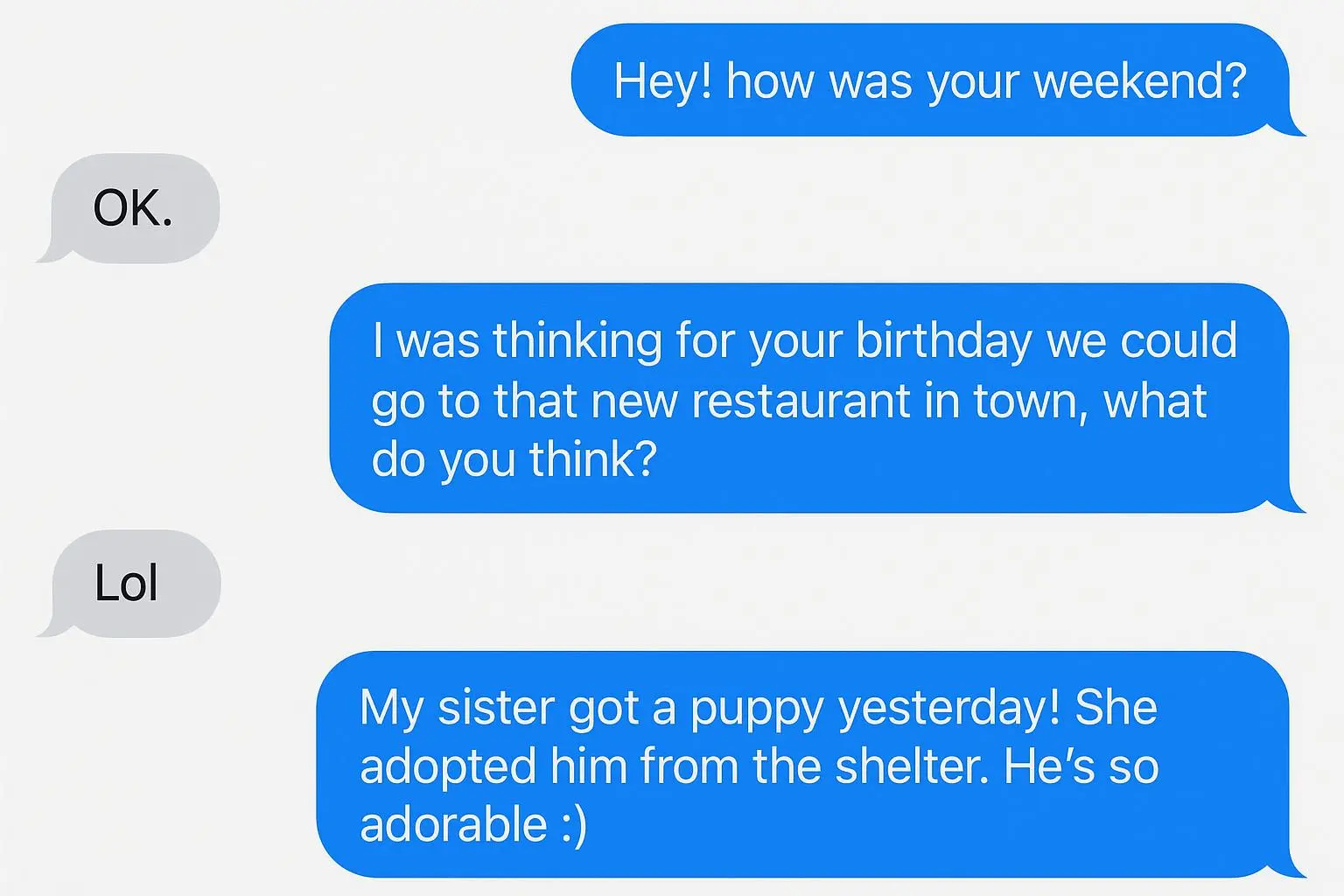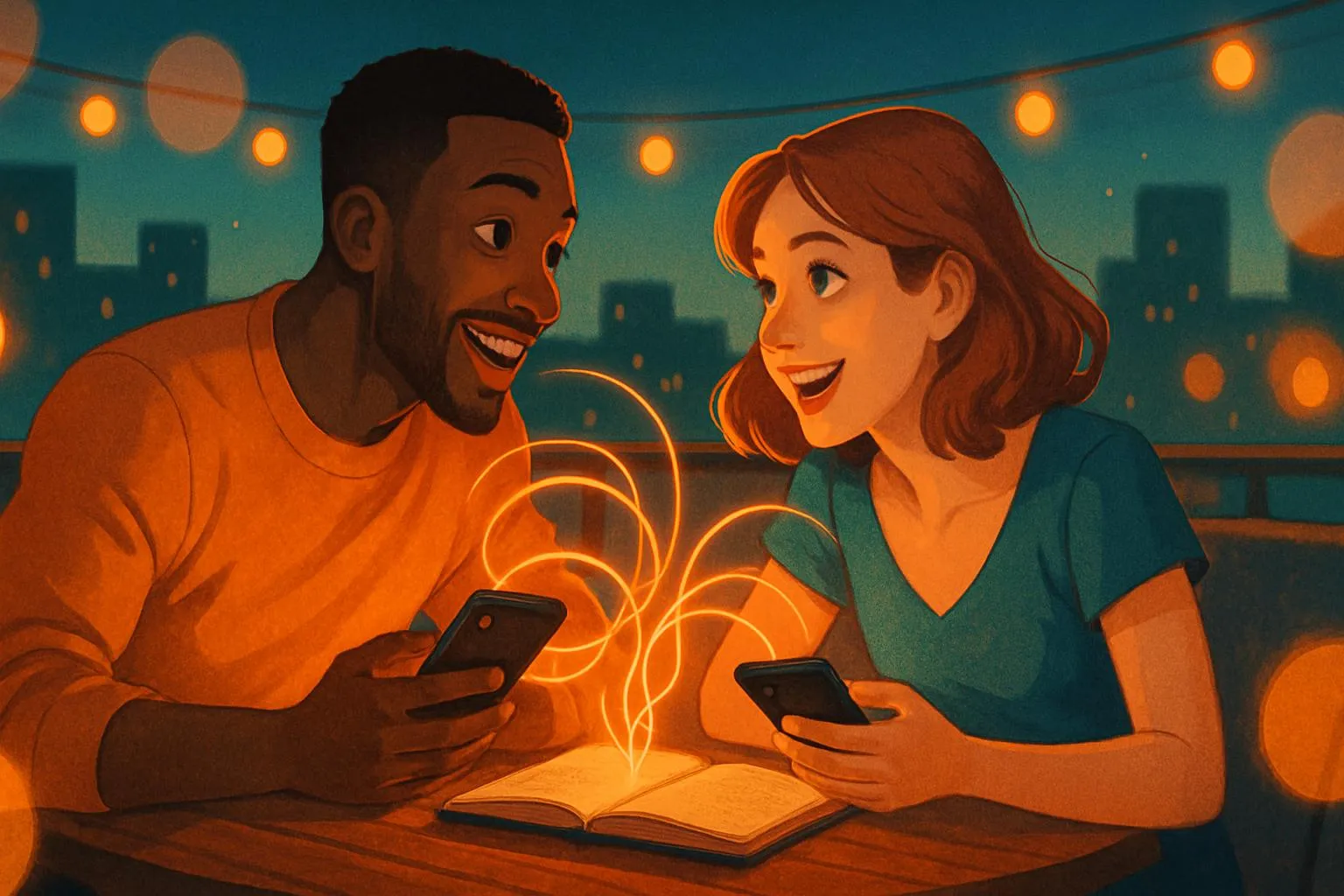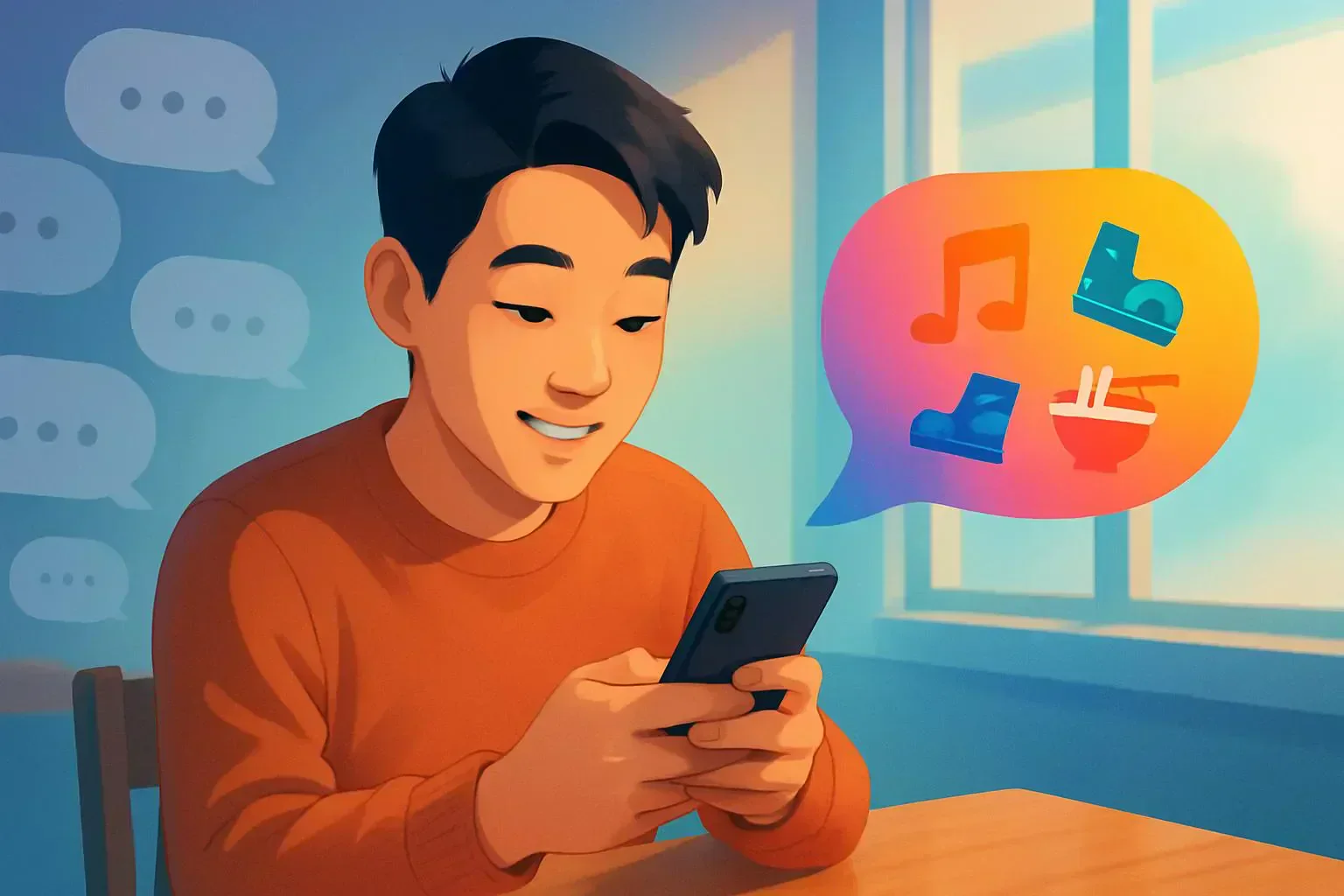
How to Handle Dry Texting Without Losing Your Cool
Published on 3/21/2025 • 6 min read
I remember the exact text that started my curiosity about dry texting: I’d spent twenty minutes crafting a playful story about my day, hit send, and got back a single “k.” I laughed, then frowned, then ran through the usual mental loop—was I boring? Did they hate me? Were they busy? That tiny reply carried more weight than the two characters deserved, and I suspect you’ve felt that sting too.
Quick context: in a small, informal two-week experiment I ran on my own conversations, a few deliberate tweaks revived about 40% of threads that had gone dry—often within one or two messages. That’s not a miracle cure, but it’s a useful baseline for what modest effort can return.
Dry texting is the modern social pothole: invisible until you hit it and suddenly your conversation stalls. In this piece I’ll explain what a dry texter is, why people send low-effort replies, and—most importantly—how to respond in ways that either revive the chat or help you save time and dignity. I’ll share things I tried (what worked, what didn’t) so you leave with realistic, usable strategies.
What exactly is a 'dry texter'?
A dry texter is someone whose replies are consistently short, flat, or otherwise lacking in conversational energy. You know the examples—“k,” “lol,” “nice,” a lone thumbs-up emoji. These responses aren’t just short; they kill momentum. They’re not meant to add to the conversation; they’re meant to close it, politely or passively.
This isn’t about one-off terse replies. Everybody is busy or distracted sometimes. Dry texting becomes a pattern: you ask, they answer in a way that doesn’t invite follow-up, and you’re left doing all the lifting. It feels a bit like trying to hype a party where you’re the only one bringing balloons.
A dry reply isn’t always a verdict on you. It’s a communication clue—ambiguous until you test it.
Classic dry responses: “k”, “lol”, “nice”, “cool”, “yup/nope”, “👍.” Each one is a small conversational stop sign.
Why are their texts so dry? Unpacking the reasons
Before you assume the worst, run through the probable causes. I used to jump to the conclusion that dry texting meant disinterest, but talking to friends, dating, and observing patterns taught me to consider context first.
- They’re genuinely busy. Work, parenting, or life can mean short replies are simple acknowledgements, not dismissals.
- They’re not a “texter” by nature. Some people prefer in-person or phone interaction and use texting as a utility.
- They’re shy or unsure what to say. Introverts and overthinkers sometimes default to safe, short responses.
- It’s just their communication style. Some people value brevity and clarity—long threads are noise to them.
- They’re not that into you. The less pleasant truth: dry texting can be a passive sign of low interest. If someone consistently avoids engagement, it’s often avoidance.
Context matters. A chronically dry response across topics and times points to low investment. A single ‘k’ after a long message? Not a crisis.
How to add moisture to a dry conversation: practical strategies that work
I prefer solutions that respect both parties’ time and dignity. Below are methods I’ve used or recommended to friends—tested in the messy real world, not just theory.
Ask open-ended, curiosity-driven questions
If you only ask yes/no questions, you’ll get yes/no answers. The trick is specificity: instead of “Did you have a good day?” try “What was the weirdest thing that happened to you today?” or “What made you laugh today?” Open questions feel riskier but they give someone something to latch onto.[1]
Match energy, then nudge it up
If they reply short, don’t immediately switch to long essays. Match their pace for a message or two, then gently raise the energy—send a playful voice note, a short video, or a meme. The transition feels less pushy and more inviting.
Use voice notes and visuals
A ten-second voice note conveys tone and warmth. GIFs, memes, and photos break monotony. I’ve revived several conversations by sending a perfectly ridiculous GIF—humor is hard to ignore.
Change the medium
Texting rewards brevity. Suggest a call or meet for coffee. Try: “This is too good for text—coffee this week?” Changing the medium often unlocks people who are flat in chat.[2]
Talk about their interests
People open up about what they care about. Ask about a hobby, a show they love, or a detail they once mentioned. Passion beats small talk.
Be playful and remove pressure
Dry texters often worry about saying the wrong thing. Low-stakes prompts work: “Rate my weirdest habit 1–10” or “If I were a pizza topping, which would I be and why?” These invite creative, low-risk responses.
Set limits and protect your time
If you’re doing all the work, step back. My rule: if a conversation still feels one-sided after a few clear attempts, I stop initiating for a week. That space often reveals whether the other person cares to reconnect.
When to use AI tools (and a disclosure)
If you want an objective read, some tools analyze tone and suggest next messages. I mention Rizzman’s Dry Text Detector as an example. Disclosure: I have no financial or sponsored affiliation with Rizzman. Use third-party tools as one input—not an absolute truth. They can offer helpful perspective, but they don’t replace direct communication.
If you try an analyzer, treat its advice as a draft: tweak the suggested message to fit your voice.
Signs it’s time to move on
Sometimes, despite effort, a conversation stays dry. That’s not failure—it’s a signal. Your energy is finite; invest it where it’s reciprocated.
Watch for these red flags:
- You’re the one initiating almost everything.
- They never ask about your life.
- Conversations feel like an interview or chore.
- They avoid switching mediums (calls or meetups repeatedly declined).
- You feel anxious or depleted after texting them.
If several are true, step back. People eager to engage will show it; those who aren’t usually won’t change dramatically.
Short, copy-pastable subject lines and openers
Use these when you want quick, ADHD-friendly options. Each is one or two lines—ready to copy and send:
- “Quick question: what made you smile today?”
- “This topic needs an expert—what’s your take?”
- “Too long for text—can we voice-note this?”
- “Rate my weirdest habit 1–10. Go!”
What to say when you’re ready to confront or bow out
If you want clarity without drama, short and honest works best. A few scripts I’ve used:
- “I feel like I do most of the texting—are you enjoying our chats?”
- “I get busy too, but I’d prefer if we were both into this. Want to talk on the phone sometime?”
- “If texting isn’t your thing, that’s fine—just say so and I won’t take it personally.”
Directness is kind: it avoids ghosting and gives the other person a chance to show up differently.
The social cost of being a dry texter (and why empathy matters)
Many dry texters aren’t trying to hurt you. It can be a coping mechanism, a habit, or just a style. Calling someone out angrily rarely helps. A little empathy can reveal whether the behavior is temporary, fixable, or a deeper mismatch.
Your feelings are valid. Treat attempts to fix things as experiments: try a method, observe the result, and adjust.
Personal anecdote
A few years ago I was dating someone I liked a lot. Early chats were easy and lively, then gradually replies shrank to single words. I tried humor, questions about their day, and a voice note; nothing much changed. After three weeks I asked, “I feel like I’m doing most of the texting—are you into this?” They admitted they were juggling grad school and felt guilty about long replies, but also said they preferred saving emotional energy for in-person time. We shifted to weekend calls and it worked for a while—until schedules shifted again. The point: clarity led to a practical compromise that respected both our limits. It didn’t make the relationship perfect, but it let us decide consciously rather than drift.
Micro-moment
I once sent a playful audio clip and got a one-word reply—“lol.” I almost stopped texting, then switched to a direct question about their favorite snack; they answered with enthusiasm and an unexpected recipe. Small shifts can flip a dry thread quickly.
Final thoughts: protect your energy and choose conversations that spark joy
That “k” text taught me the currency of attention matters. Texting is a small ecosystem of signals, preferences, and boundaries. A dry reply isn't always a breakup—it's a riddle. With curiosity, tact, and sometimes a little technological help, you can usually tell whether a conversation is worth saving.
If it’s not, that’s okay. The people who return your energy are worth leaning into. Letting go of slow, one-sided chats isn’t defeat; it’s decluttering your social life so better connections have room to grow.
You don’t have to win every conversation. You just have to make sure the ones you keep are worth your time.
References
Footnotes
-
Walther, J. B. (1992). Social information processing theory of interpersonal communication in computer-mediated contexts. Journal of Communication. ↩
-
Ellison, N. B., Heino, R., & Gibbs, J. L. (2006). Managing impressions online: Self-presentation processes in the online dating environment. Journal of Computer-Mediated Communication, 11(2), 415–441. ↩
Ready to Optimize Your Dating Profile?
Get the complete step-by-step guide with proven strategies, photo selection tips, and real examples that work.


